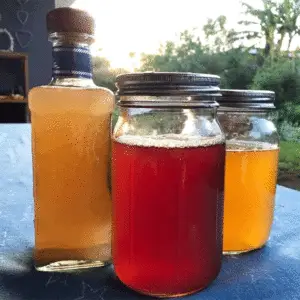Kombucha is a refreshing way to use leftover fruit produce from your garden or fruit basket. It is a fruity, fizzy, refreshing drink that’s a great alternative to wine and beer. At the same time, there is some evidence that kombucha’s natural pre- and probiotics are good for us. So, it’s refreshing AND possibly even good for you. What a win!
The key to a good kombucha is, of course, a good mother plant or scoby. ‘Scoby’ stands for Symbiotic Culture Of Bacteria and Yeast. We supply a proven mother scoby to start off your brew. If cared for, your mother scoby will produce other mothers that you can store in a scoby ‘hotel’ or give away to friends. (More of that below.)
Please bear this in mind when you use one of our scobies:
- Making your own kombucha is at your own risk. Please also practise responsible kitchen hygiene and safe storage at all times.
- Please note that a by-product of fermentation in the kombucha-making process is alcohol. It’s not a significant percentage but it is there.
In the box
- A Consol preserving jar with lid and ring, and a round of cotton
- In the jar: a scoby and a portion of kombucha starter
First unbox your scoby
Your scoby will arrive in a Consol preserve jar, together with a portion of kombucha starter. Although the jar will be cooled and sealed just before dispatch, it’s important to open it up as soon as you receive it so that the organisms can breathe. You don’t want to leave your scoby airless. That’s just cruel. 🙂 The round of cotton can be secured in place using the Consol ring (remove the metal lid) to let your scoby breathe at room temperature, and to keep out the fruit flies that seem to love kombucha.
How to get your brew going
You’ll need:
- Black tea (bags or loose leaf)
- A sieve (for the leaves, if you use them)
- Filtered water – boiled
- A large vessel – either start out and test the process in the Consol jar provided, or go big with a preserving quality five-litre jar
- Sugar (or honey)
- For the second fermentation:
- Clean jars and bottles
- A variety of fruit. You don’t need much at all – half an orange, fresh pomegranate juice, strawberries, dried apricots etc.
What to do:
It took me a couple of kombucha failures to realise two things: secondary fermentation is where the flavour’s really at and, if you have to park your scoby for months, if not years, it’s not an issue if you keep them in a scoby ‘hotel’.
Don’t discard the starter liquid even if it smells a bit ‘sour’ or vinegary. This liquid is necessary for your first (and following) brew.
Start by making sure your hands, utensils, containers and surfaces are spotlessly clean. Good kitchen hygiene really counts here. Make a good few litres of strong black tea, preferably using filtered water. When I add the boiling water I’m very careful to do it slowly, and bring the jar up to temperature – you don’t want to shock it and break the glass, or spill water while you’re in a hurry. For a five litre container I use at least five tea bags or five tablespoons of loose tea. It’s best to start off with a simple black tea … and then move to green or white teas, or flavoured teas like Earl Grey.
Remove the tea bags or strain the leaves and then add a good amount of sugar to the tea, stir and let it cool, covered. I usually use about a cup of sugar but you can experiment as you go – and you might find you prefer more sugar or less. It’s all food for the scoby after all. The sweet tea creates a happy place for the scoby to do its thing – it is the correct pH and also has the caffeine and other goodies that the scoby uses to grow and thus convert the tea into fizzy deliciousness.
Once the sweet tea is cool you can add the kombucha starter and gently lower the scoby into the tea. The scoby will probably sink to the bottom. Don’t worry about that. Cover with the cotton round and secure in place with an elastic band, or string.
Leave the sweet tea mix in a cool place, away from the sun. After a few days you’ll notice that there will be a film on the surface of the tea. This is the new scoby forming. The original scoby may start rising to the surface. (If it doesn’t, that’s okay.) You’ll also notice the tea becoming lighter in color. As the scoby develops it will get thicker – to about 5 mm. There will also be a build up of little bubbles under the scoby as the fermentation takes place and the fizz starts. After five to ten days, depending on room temperature, the fizz and the scoby will have developed enough for you to remove the scoby.
You made it! Now what?
The kombucha brew will be tasty on its own at this stage, and very lightly fizzy. The magic happens when you add fruit to that liquid and then let it start a second fermentation. (Remember to retain some kombucha liquid with the mother scoby, for storage.) Use fruit that’s past its prime, or cut out the damaged parts and use the remainder. Your kombucha scoby doesn’t judge.
The kombucha will take on the flavour and color of the added fruit as it ferments on the fructose sugars (instead of the sucrose from the original sugar). It will also become more fizzy. I tend to leave the top of the jar or bottle a little loose but then I’m ultra-cautious. When I’m happy with the amount of bubbles being generated by the mix then I remove the fruit, add the kombucha to sterilized bottles, cap them and then place them in the fridge. And ta da … you have your kombucha drink.
I like making three different flavours at time, in separate jars or bottles. And in summer, it’s good to have two batches of base kombucha going, overlapping each other, to keep a kombucha supply going.
Scoby hotel
If the excitement of creating your own kombuchas wears off, or if you find that you have too many scobies and haven’t found homes for them, then why not create a scoby hotel? Basically this is a large jar with sweet tea and a portion of kombucha to which multiple scobies are added. Place in a cool, dark place, with a cloth covering the mouth of the jar, and let them be. Some people pop them in the fridge where they go into suspended animation, waiting to be activated. The room temp scobies will free up fridge space and quietly consume the tea, and reproduce. Every few months check them, and clean out the old scobies. When you want to make kombucha again, they’ll be ready for you.
Old scobies – what to do?
The original scoby may eventually start looking tired. You’ll notice it isn’t as firm, and its surfaces start sloughing off and its color darkens. When you have a good stock of new scobies then the old ones can be discarded … or used to make more. It’s up to you. The old scobies can be popped into your compost or given to your hens, if you have any.
There are some very good Youtube videos which show various ways of making kombucha – you’ll find your own way of producing the drink that you and your family and friends enjoy.
Cheers to fizzy fun!

